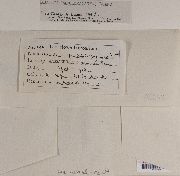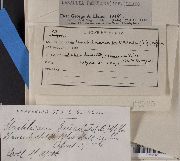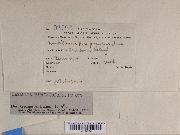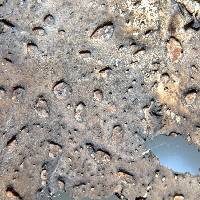
Consortium of Lichen Herbaria
- building a Global Consortium of Bryophytes and Lichens as keystones of cryptobiotic communities -
- Home
- Search
- Images
- Species Checklists
- US States: O-Z >
- US National Parks
- Central America
- South America
- US National Parks
- Southern Subpolar Region
|
|
|
|
Family: Umbilicariaceae
[Gyrophora papulosa Ach., moreLasallia papulosa (Ach.) Llano, Umbilicaria pustulata var. papulosa (L.) Hoffm.] |
Nash, T.H., Ryan, B.D., Gries, C., Bungartz, F., (eds.) 2004. Lichen Flora of the Greater Sonoran Desert Region. Vol 2. Thallus: umbilicate, monophyllus, rarely polyphyllus, up to 9 cm in diam., with abundant pustules more or less radiating from the center; margin irregular or scalloped; margin and pustules occasionally developing adventive lobes upper surface: gray or ashen gray, sometimes brown or covered with rusty red pruina, slightly areolate, scabrous to strongly areolate or even echinate toward the center of the thallus upper cortex: paraplectenchymatous, with a brown walled layer of cells on the upper part; epicortex: usually discontinuous, up to 60 µm thick, composed of hyaline, large, leptodermatous cells, giving a strongly areolate, whitish aspect to the upper surface of the thallus, 30-40 µm thick medulla: composed of two layers; upper part: 20-35 µm thick, arachnoid, hyphae crystalline and leptodermous; lower part: prosoplectenchymatous, with pachydermatous hyphae of variable thickness, decreasing when deeping into pustules, sometimes disappearing towards the upper layer, up to 60 µm thick in the intermediate, non-pustulate thallus areas algal layer: continuous, 30-45 µm thick lower cortex: paraplectenchymatous, light brown to dark brown in the lower part, 20-40 µm thick lower surface: ashen gray, creamy or brown, often blackish around the umbilicus, smooth to slightly areolate Apothecia: common, up to 2.5 mm in diam., sessile to subpedicellate; disc: flat to undulate, dark brown to black; margin: smooth to crenate asci: clavate, 1-spored ascospores: hyaline initially, becoming brown, muriform, 55-100 x 30-44 µm Spot tests: upper cortex K- or K+ purple, C+ red, KC+ red, P- Secondary metabolites: gyrophoric acid, papulosin and anthraquinone pigments. Substrate and ecology: growing on sandstones, granites, rhyolites and other acid rocks, on xeric surfaces World distribution: widely distributed in North America, ranging from Canada to Mexico Sonoran distribution: frequent in Arizona and Chihuahua over 2000 m in upper montane and forests. Notes: The Sonoran specimens of L. papulosa are strikingly similar to those of L. hispanica from the southwestern Mediterranean basin. Lasallia hispanica mainly differs from L. papulosa in having laminal isidia and smaller ascospores. Moreover, the adventitious lobes of L. papulosa differ very little much from the laminal isidia of L. hispanica. Whether this is an evolutionary convergence to a similar habitat or a taxonomical very close species is an open question, that should be examined by molecular analysis. Some specimens of L. papulosa show an almost entirely blackish and areolate lower surface, that apparently does not differ from those of L. pensylvanica. However, the lower cortex of L. papulosa never has a necrotic, scleroplectenchymatic layer, but rather has a paraplectenchyma layer with wall cells ranging from light to dark. |
|
|
|
Powered by Symbiota




































































































